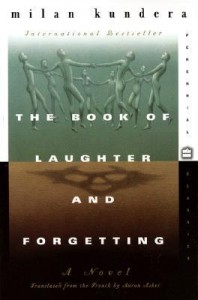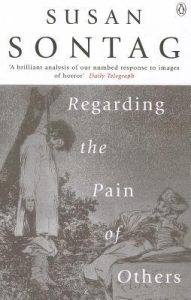Is there a relationship more complex than that between a mother and a daughter? Love and admiration mix ineffably with jealousy and resentment. Through the seemingly simple (but deeply layered) language of Marble Skin, Slavenka Drakulić unweaves the conflicts and emotions that estrange and entangle women.
A girl admires her mother’s body and yearns for the day when her own will blossom. If she becomes impatient with the slowness of her growth, jealousy of her mother’s womanliness can take root. The mother in turn becomes jealous of her daughter’s youth.
Drakulić’s narrator deftly slips through time as she expresses this love, admiration, and resentment for her mother. She outlines with equal complexity the feelings of a burgeoning adolescent for her stepfather and how his presence catalyzes the relationship between mother and daughter.
”We don’t have a body, we are a body” – Slavenka Drakulić
At the beginning of the book, the narrator is reflecting on an art show and a comment by a friend that her “sculptures of the female body seemed eaten away from the inside.” She begins sculpting her mother’s body. As she shapes breasts and thighs, she begins thinking of her mother’s body and of a scene she witnessed as a child.
The Primal Scene
Psychoanalysts talk about the primal scene when a child witnesses a sex act and it affects her view of sexuality for life. The narrator views a watches her stepfather in a sexual act with her mother in their marriage bed. It is an act this man will later reenact with the girl.
The way Drakulić crafts the scene, with a gentle allusion to Alice in Wonderland, the reader simultaneously experiences the dread of entering the room as an adult and the memory of the mother’s body splayed on the bed. Without revealing the later molestation, the reader is still left with the sense of a lurking secret. The sense of the small child within all of us.
What was most haunting about the book for me was that these are normal human emotions that I have experienced but never knew how to express. Drakulić split open her characters and subjected them to horrible things and their responses always returned to the common human reactions. Witnessing the girl’s devastation of sexuality helped me understand my own relationship with sexuality.
The Craft of Writing
It may be evident by the somewhat articulate nature of this post so far, but this book invaded my psyche in a way I can’t yet understand. The simple sentences expressed emotions I had been trying to unlock and explain for decades. The metaphors were gentle and expansive. The literary allusions were subtle and perfect.
”With this one sentence I emptied her out, like squeezing a tube of oil paint.” – Slavenka Drakulić
Drakulić emptied me out too. Her writing ate away at me from the inside. I’m putting the book aside until I can read it again. I think I can read and reread this book for decades and it will still have things to teach me about writing and about being a woman. That is the most beautiful feeling in the world.
If this review made you want to read the book, pick up a copy of Marble Skin from Bookshop.org. Your purchase keeps indie booksellers in business and I receive a commission.
 Milan Kundera discusses variations in The Book of Laughter and Forgetting: “Variation form is the form in which concentration is brought to its maximum; it enables the composer to speak only of essentials, to go straight to the core of the matter.” He goes on to write, “This book is a novel in the form of variations. The various parts follow each other like the various stages of a voyage leading into the interior of a theme, the interior of a thought.” The form he chooses to use for this book, the form of variations, provides the majority of the structure for the novel.
Milan Kundera discusses variations in The Book of Laughter and Forgetting: “Variation form is the form in which concentration is brought to its maximum; it enables the composer to speak only of essentials, to go straight to the core of the matter.” He goes on to write, “This book is a novel in the form of variations. The various parts follow each other like the various stages of a voyage leading into the interior of a theme, the interior of a thought.” The form he chooses to use for this book, the form of variations, provides the majority of the structure for the novel.
 I tried to forget about the graves as we flew to Dubrovnik and entered the beautiful, walled old Town. For a couple of days I was a right good tourist exploring the sights and spending money. But I kept looking for signs of the war. The guidebook said the only evidence we would see of the bombing of Dubrovnik was the new red tile roofs. It wasn’t until walked the walls that I saw that most of the roofs were the bright red of new tile. Almost no building was left untouched. I wanted to think that there were other reasons for some of the new roofs, but there were so many of them…I was curious and I wanted to know more, but I didn’t know who to ask and I didn’t want to be rude. I wanted to see the place for more than its war experiences, but I couldn’t stop thinking about it.
I tried to forget about the graves as we flew to Dubrovnik and entered the beautiful, walled old Town. For a couple of days I was a right good tourist exploring the sights and spending money. But I kept looking for signs of the war. The guidebook said the only evidence we would see of the bombing of Dubrovnik was the new red tile roofs. It wasn’t until walked the walls that I saw that most of the roofs were the bright red of new tile. Almost no building was left untouched. I wanted to think that there were other reasons for some of the new roofs, but there were so many of them…I was curious and I wanted to know more, but I didn’t know who to ask and I didn’t want to be rude. I wanted to see the place for more than its war experiences, but I couldn’t stop thinking about it.